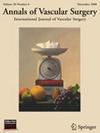法国多中心注册的LUMINOR药物洗脱球囊用于股浅动脉和腘动脉(lumiffollow)的两年结果
IF 1.6
4区 医学
Q3 PERIPHERAL VASCULAR DISEASE
引用次数: 0
摘要
背景:药物包覆球囊技术在下肢血运重建中显示出越来越大的潜力,1年的结果显示出可接受的安全性和有效性水平,并改善了生活质量。这项随访研究评估了这些优势是否持续超过2年。方法:LUMIFOLLOW登记纳入了15个中心的542例患者,共580个病变。它包括新生和再狭窄病变,钙化和/或长闭塞。主要终点是医疗安全性(无术中死亡、食指截肢和/或全因死亡率)和有效性(原发性通畅定义为无靶病变血运重建术(f-TLR)和/或再狭窄)。次要终点包括器械、手术和临床成功、主要不良事件和功能评估。结果:平均年龄71.2岁,男性占67.2%;卢瑟福分类(Rutherford classification, RC) 2占23.8%,RC 3占43.2%,RC 4占16.8%,RC 5占16.2%;57.5%病变位于股浅动脉,延伸至腘动脉(42.5%),再狭窄占24.2%,全闭塞占44.3%。平均病变长度为140.55±99.42mm。43.1%的患者需要临时支架植入术。急性临床成功率为93.5%。2年后,351/542例(64%)患者仍留在研究组,48例死亡。估计原发性通畅率为73.9% (95%CI: 69.3-77.9%);f-TLR为92.0% (95%CI: 88.7-94.4%)。亚组分析显示,f-TLR和原发性通畅率在疾病严重程度(TASC分类)、新生与支架再狭窄以及病变位置之间没有差异。生活质量(QOL)的改善为63.1%的活动能力改善,60.2%的疼痛减轻,40.2%的日常活动增强。结论:Luminor DCBs对股腘动脉干预安全有效,在严重动脉疾病、再狭窄、SFA和腘窝领域的结果相同。显著改善生活质量和行走能力,高原发性通畅和低并发症发生率,强调了Luminor DCBs在现实环境中的益处。本文章由计算机程序翻译,如有差异,请以英文原文为准。
Two-Year Outcomes of the French Multicentric Registry on LUMINOR Drug-Eluting Balloon for Superficial Femoral and Popliteal Arteries (LUMIFOLLOW)
Background
Drug-coated balloon (DCB) technology is demonstrating increasing potential in lower limb revascularization; 1-year results demonstrate acceptable levels of safety and efficacy and quality of life improvements. This follow-up study assessed whether these advantages persisted over 2 years with the Luminor DCB.
Methods
The LUMIFOLLOW registry enrolled 542 patients with 580 lesions across 15 centers. It included both de novo and restenotic lesions and calcified and/or long occlusions. Primary endpoints were medical safety (freedom from periprocedural death, index limb amputation, and/or all-cause mortality) and efficacy (primary patency defined as freedom from target lesion revascularization (f-TLR) and/or restenosis). Secondary endpoints included device, procedural and clinical success, major adverse events, and functional assessments.
Results
The mean age was 71.2 years, with 67.2% men; 23.8% were Rutherford classification (RC) 2, 43.2% were RC 3, 16.8% RC were 4, and 16.2% were RC 5; 57.5% of lesions were in the superficial femoral artery (SFA), 42.5% extended to the popliteal artery, with 24.2% restenosis and 44.3% total occlusions. Mean lesion length was 140.55 ± 99.42 mm. Provisional stenting was required in 43.1%. Acute clinical success was 93.5%. By 2 years, 351 of 542 (64%) patients remained in the study group, 48 patients had died. Estimated primary patency was 73.9% (95% CI: 69.3–77.9%); f-TLR was 92.0% (95% CI: 88.7–94.4%). Subgroup analyses showed no differences between f-TLR and primary patency rates between disease severity (TASC classification), de-novo versus in stent restenosis, and lesion location. Improvements in quality of life (QOL) were 63.1% improved mobility, 60.2% reduced pain, and 40.2% enhanced usual activities. Walking Impairment Questionnaire scores demonstrated sustained improvements (61.2 ± 30.0, P < 0.001).
Conclusion
Luminor DCBs are safe and effective for femoropopliteal interventions, with equity in results in severe arterial disease, restenosis, SFA, and popliteal territories Significant improvement in QOL, walking ability, high primary patency, and low complication rates underscore the benefits of Luminor DCBs in real-world settings.
求助全文
通过发布文献求助,成功后即可免费获取论文全文。
去求助
来源期刊
CiteScore
3.00
自引率
13.30%
发文量
603
审稿时长
50 days
期刊介绍:
Annals of Vascular Surgery, published eight times a year, invites original manuscripts reporting clinical and experimental work in vascular surgery for peer review. Articles may be submitted for the following sections of the journal:
Clinical Research (reports of clinical series, new drug or medical device trials)
Basic Science Research (new investigations, experimental work)
Case Reports (reports on a limited series of patients)
General Reviews (scholarly review of the existing literature on a relevant topic)
Developments in Endovascular and Endoscopic Surgery
Selected Techniques (technical maneuvers)
Historical Notes (interesting vignettes from the early days of vascular surgery)
Editorials/Correspondence

 求助内容:
求助内容: 应助结果提醒方式:
应助结果提醒方式:


